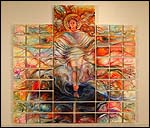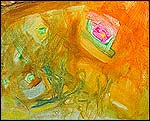
|

Houria, 2000 Oil, acrylic and gold leaf on cotton duck Lent by the artist (Photo: Harry Foster © Canadian Museum of Civilization Corporation) Note: Houria is a first name which was frequently given to girls in Algeria during the 1950s. For the artist, Houria symbolizes the women of Algeria. "Red ochre, burned earth, scent of my land, I am a prisoner. My hand, my eyes, my heart search for you. I will find you again. The child who was born cried out - a cry of liberty? Forgive me, my mother, I have left you, but my heart is there, very close to you. I hold you tight in my arms.
To my Mother"
"I do not think that another country can bring me solace, not so long as the problem in my own country still exists. But I am thinking above all of stability for my children. [...] For me, the most
beautiful thing is hope, and light."
Extracts from a text by the artist and an interview Hadjira Preure was born in Algeria in 1954, the same year that the uprising of the Algerian people led to the war for independence. Following in her father's footsteps, she began studying law, but quickly reoriented herself towards the visual arts. She earned a certificate in the teaching of art (1981), then a national diploma (1982), from the École supérieure des beaux-arts d'Alger. The holder of a state grant, she left Algeria with her husband, the artist Ali Kichou, for Italy, where she spent the first year in Perugia and the following 13 years in Rome.  Hadjira Preure with her daughter Tinhinane Yasmina Kichou , Montreal, Quebec, 2000 Rawi Hage Gelatine silver prints Collection of the Canadian Museum of Civilization A graduate in painting from the Fine Arts Academy of Rome (1987), she became an assistant to the sculptor and painter Tito. Meanwhile, the situation in Algeria and the birth of children compelled the couple to find a country where their family would not feel like strangers, where they could enjoy the benefits of social rights, and where there would be neither war nor violence. Canada finally accepted them, and she arrived in Montreal with her husband and children in 1995. Migrations, multiple relocations and confined spaces led her to work with smaller surfaces: But I always hope to give depth to the painting, the impression of something big, even if it is very small. . . . Working in smaller formats allows me to better dominate surfaces.  Houria (detail) , 2000 Oil, acrylic and gold leaf on cotton duck Lent by the artist (Photo: Harry Foster © Canadian Museum of Civilization Corporation) Interested at first in a realistic approach to painting, she painted animals (in a realistic style) and landscapes (inspired by Monet and Degas) as well as portraits (in the style of Daumier), and then discovered primitive art with the cave paintings and frescoes of Tassili. She adopted an expressionism-of-colour style and became a member of the group Movimento Trattista, which promotes the use of the free stroke and the "sign." Through the use of ancient techniques-waxwork, engraving, sculpture and egg tempera-she endeavours to render movement and emotion. For her, the most beautiful thing is hope, light. And it is to set off that light that she creates areas of darkness in her paintings. Hadjira Preure has participated in some 40 exhibitions in Canada, in Europe and in Algeria, and her works are included in the collections of numerous European museums, particularly in Italy. |